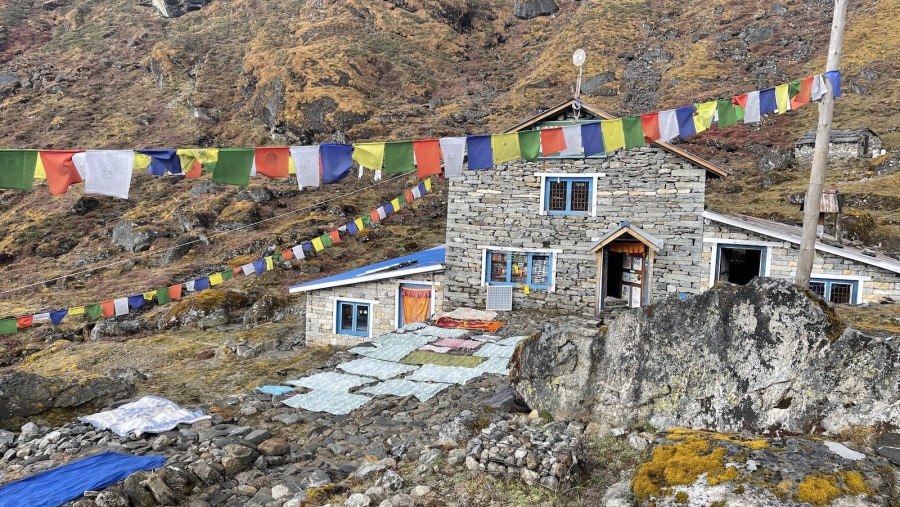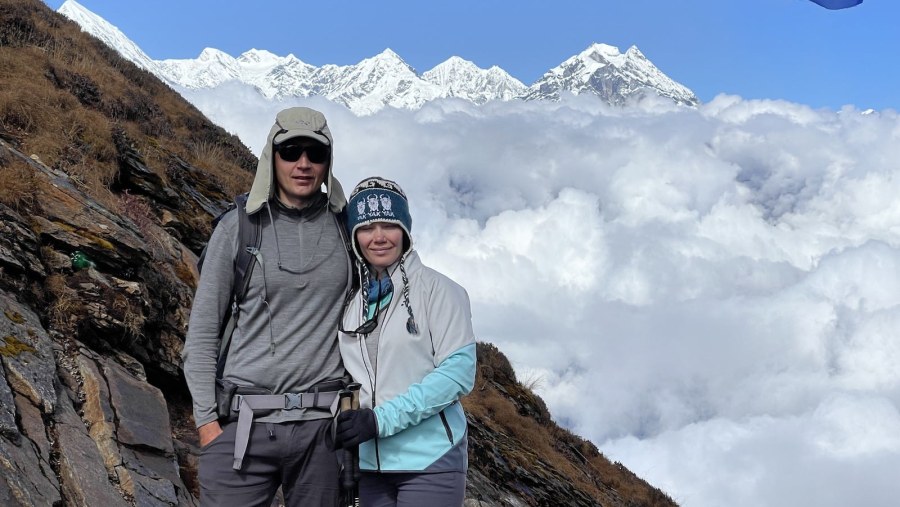17-Day Mera Peak Trek From Lukla
Description
Climb to the highest trekking destination in Nepal - Mera Peak on this 17-day Mera Peak trek from Lukla. Summit to Mera Peak is quite popular due to the accessible level of challenge the trail offers, even given the considerable summit height – 6476m. On the trek, enjoy the views of five of the world’s six highest mountains – Cho Oyu, Makalu, Kanchenjunga, Lhotse and Everest. Check out the trail for the three beautiful Imja, Hinku and Hongu valleys.
Highlights
- Climb Mera Peak - the highest trekking destination in Nepal
- Explore the three valleys of Imja, Hinku and Hongu on your trek
- Locate the five most beautiful lakes (the Panch Pokhari) in Hongu Valley
- Trek through the pinewood and rhododendron forests on your trail
Itinerary Expand All Collapse All
-
Day 1: Arrival in Kathmandu expand_more
- Arrive in Kathmandu, accommodation at a hotel and rest after the trip.
-
Day 2: Sightseeing Tour in Kathmandu expand_more
- Obtaining permits that are required for the ascent.
- A sightseeing tour in Kathmandu and lodging in a hotel.
-
Day 3: Kathmandu to Lukla expand_more
- Flight from Kathmandu to Lukla (to an altitude of 2800m).
- Accommodation at a lodge.
-
Day 4: Trek to Chutang Village expand_more
- Trek to the village of Chutang (at 3370m), followed by a climb to an elevation of 4000 m underneath the mountain passage.
- Staying in Chutang village.
-
Day 5: Climb Zatrva La (4800m) expand_more
- 6 to 8 hours climb through passage Zatrva La (at 4800m).
- Stay at Tuli-Kharka village (at 4250m).
-
Day 6: Descent to Gote Village expand_more
- 4 to 6 hours descent to the village of Gote (Gotar) to the altitude of 3600m.
- Accommodation at a lodge.
-
Day 7: Trek to Tagnag Village expand_more
- Trek to the village of Tagnag (at 4350m).
- Accommodation at a lodge.
-
Day 8: Trek to Khare Village expand_more
- 3–4 hours trek to the village of Khare at 4950m.
- Lodging in a hut.
-
Day 9: Rest Day in Khare Village expand_more
- An acclimatization and rest day in Khare.
- Accommodation at a Lodge.
-
Day 10: Climb Mera Peak expand_more
- Climb to Mera Peak’s last pre-summit camp at 5800m (tents).
-
Day 11: Summit Mera Peak expand_more
- Mera Peak summit day – to the altitude of 6476m – followed by a descent to Khare.
- Accommodation at a lodge.
-
Day 12: Acclimatization expand_more
- This Mera Peak climbing expedition day is reserved in case of bad weather.
- Accommodation at a lodge.
-
Day 13: Descent to Gote Village expand_more
- Descent to an elevation of 3600 m – to Gote (Gotar).
- Accommodation at a lodge.
-
Day 14: Climb to Zatrva La expand_more
- Climb to Zatrva La passage.
- Overnight stay in the village of Tuli Khakha (at 4250 m).
-
Day 15: Descent to Lukla expand_more
- Descent to Lukla and lodging in a sunroom.
-
Day 16: Lukla to Kathmandu expand_more
- Lukla to Kathmandu flight.
- Transfer to a hotel.
-
Day 17: Departure expand_more
- International flight from Kathmandu airport.
What's Included
- Services of professional mountain guides (in the proportion of 1 per 3 climbers on the summit day)
- All transfers mentioned in the itinerary
- All accommodation mentioned in the itinerary above – hotels and lodges
- Permits for climbing and national park fees
- Meals all through the climbing (prepared by a cook), but only breakfasts when in cities
- Sightseeing tours are mentioned in the itinerary
- All group equipment
- Garbage deposit
What's Excluded
- International flights
- Personal gear
- Medical insurance for mountain climbing
- Lunches and dinners in cities
- Expenses incurred by any changes to the mentioned itinerary
- Services of rescuing and evacuation
- Tips
- Drinks
- Any costs caused by the changing of the programs
What to bring
Documentation:
- International passport
- Airplane tickets
- Medical insurance covering helicopter evacuation
Personal equipment:
- Backpack 30-50l
- Sleeping bag, comfort temperature from -20C
- Mat
- Trekking poles
- Cats of steel
- Ice axe with self-insurance
- Climbing system
- Helmet
- Carabiners – 4 pcs
- Lanyard moustache
- Zhumar
- Descender
- Mug-spoon-bowl
Clothes and shoes:
- Climbing boots triple or double, double–plastic or leather
- Trekking boots are well-impregnated in advance with a special anti-water agent
- Sneakers (for the city)
- Waterproof membrane layer – jacket + trousers
- Fleece suit
- Thermal underwear top+bottom
- Middle-class puff
- Warm mittens
- Gloves are thick
- Thin gloves
- Bandana or buff (in addition to protection from the Sun in the valley, it can be used to warm the throat or face in the cold)
- Cap
- Warm trekking socks for climbing day
- Windproof mask for the lower part of the face
Travel accessories:
- LED flashlight for head
- Powerbank
- Sunglasses
- Raincoat
- Rain cover for backpack
- Ski goggles
- Thermos – 1l, preferably without a button on the lid
- Sunblock spf 50
- lip balm spf 10-15
- Leggings
- Chemical heating pads (not required, but can be beneficial)
- Personal medical kit
- Elastic bandage and/or support bandage
- Toothpaste, brush, soap, shampoo, slippers
- Towel
- Toilet paper (sold in loggias along the way)
Know before you go
Trekking in Nepal implies it is fairly easy walking along mountain paths. Today, there are numerous trekking and climbing trails in Nepal. Prices of such tours are also different, depending on the offered itinerary.
The first ascent to Mera Peak was made in 1953 by Sen Tensing and Jimmy Roberts. The trekking trail leading to the Base Camp passes through pinewood and rhododendron forests located in an unpopulated remote valley.
Mera Peak trekking trail passes through three valleys of impressive beauty – Imja, Hinku and Hongu. One of the most interesting sections on this trail is that between the ice passage Ambu Labsa and Imja Valley, with a mountain lake located there. Another group of five most beautiful lakes (the Panch Pokhari) are located on the other side of the passage, in Hongu Valley.
The least challenging and most popular trails to Mera Peak summit lead from the northern side and through the Mera La passage. As a rule, those trails include sections passing through closed glaciers at a pretty high altitude. The views of Everest, Chamlang, Barutze and other equally impressive peaks open from Mera La passage, at an elevation of 5415m.
The trail to the southern slope passes through the tribal settlements of Jiri and through Pangkongma at an elevation of 3173m. The trail from the eastern side, from the city of Lukla, leads through the Zatrva La passage (at 4600m).
Mera Peak climbing trail passes through an open snowy slope and further, via the left crest and the Southern summit, 6065m high. From that spot, we can traverse to the Northern summit (6475m) through the Central summit, which is 6,461 m high. The central summit is technically more challenging and features a ledge rock on its northern slope. Straight trails lead to both summits, but due to the great number of crevasses on the mountain’s slopes, those trails are more dangerous.
For a long time, Mera Peak climbing was classified as F (facile/easy), but later, due to the crevasses that formed on the last 30–40 meters of its trail, the category of its challenge was raised to PD (Peu difficile/not very hard).
Meeting Point
Kathmandu, Nepal
Cancellation Policy
For cancellations upto 2 days before the tour -
Refund of 80% of the tour price.Price Details
| Persons | |
| 1 To 20 | USD 3500 Per Person |
This is a private tour | |







